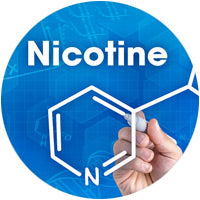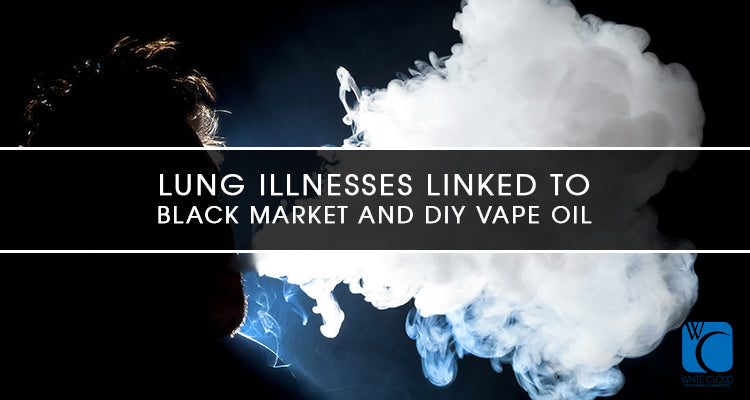As you may already be aware thanks to the media’s flurry of headlines in these last few weeks, vaping is in the spotlight as the culprit for a lung illness that has been spreading across the U.S. With hundreds of cases, including six fatal, the Centers for Disease Control (CDC) began urging the public to refrain from vaping, and now the Trump Administration is preparing a ban on all flavored electronic cigarettes. But are electronic cigarettes really the cause?
E-Cigs Caught up in Crosshairs of Recent Surge in Lung Illnesses
On September 11, 2019, the Food and Drug Administration (FDA) issued a press release stating the agency’s intention to finalize a policy to prioritize enforcement of the premarket tobacco application (PMTA) process regulating flavored e-cigarettes, including mint and menthol, and plans to implement regulations in the coming weeks. Although the FDA has not issued any specific guidelines, several high-ranking employees of the department have said the goal of any future regulations will be to eliminate flavored vaping liquids to combat youth vaping. Oddly enough, the press release doesn’t even mention the recent outbreak in lung illnesses and the suspected causes.
In late August of 2019, the Centers for Disease Control and Prevention (CDC) made an announcement that there were nearly 150 possible cases of severe lung illnesses linked to the use of vaping devices. The nearly 150 possible cases spanned 15 states and has continued to rise, with the estimate now around 380. Of course, opponents of vaping took this as a chance to attack the vaping industry and further efforts for harsh regulations, while shifting the focus back to the teen vaping “epidemic”.
Dr. Michael Siegel, a professor of community health at Boston University, has been covering all of the headlines as they unfold with his blog “The Rest of the Story”. The illness first emerged as a “mystery”, with Siegel stating, “It is very unlikely that this is being caused purely by nicotine-containing e-liquids,” and that the adverse health consequences are possibly caused by a “contaminant that is present in certain formulations of cannabis products.” The lung illness appears to be taking the form of lipoid pneumonia, a condition that occurs when fat particles enter the lungs.
What’s Really Behind the Recent Lung Illnesses?

The FDA’s decision to move forward with vaping industry regulations begs an important question: What is really behind the recent vaping illnesses? A breakthrough in the investigation into the surge of lung illnesses supported Siegel’s theory with the discovery of a specific ingredient being used as a thickening agent in illicit THC vape vapes.
Shortly before the FDA issued its press release, New York health officials declared the presence of Vitamin E in illicit THC vapes used by 34 recently admitted patients to be the primary culprit in the development of lung illnesses. New York Health Commissioner, Howard Zucker, said Vitamin E acetate was detected in “nearly all cannabis-containing samples.” The Washington Post has also reported on stories linking the presence of Vitamin E acetate in marijuana vaping products used by lung illness patients. Fungicides have also been linked to the growing number of lung illness cases.
Should Nicotine E-Cigs be Avoided?

Does the admission of around 380 patients for the treatment of lung illnesses justify the CDC’s warning against e-cigarette use and the proposed ban on flavored nicotine e-liquids? Especially in a nation where millions of Americans use vaping products and smoking rates have hit an all-time low?
According to Siegel, “Most if not close to all traditional, nicotine-containing electronic cigarette liquids are not oil-based, but water and alcohol-based. They are nearly uniformly made up of some combination of propylene glycol, glycerin, water, nicotine, and flavorings. Thus, there is little risk of lipoid pneumonia associated with traditional e-cigarettes.”
Siegel believes the CDC is being irresponsible with unclear, vague warnings about vaping without a specific warning against using marijuana vapes and also believes the proposed ban of flavored nicotine-containing e-liquids will substantially boost cigarette sales. He states that the ban “obviously makes no sense at all” and that “the logic is basically: Product X is causing a severe disease outbreak. Product Y is not. So we are going to immediately ban Product Y.” He fully believes the ban will “drive masses of ex-smokers from vaping back to smoking.”
This could indeed be the case as investors are being alerted that the ban would substantially boost the sale of cigarettes. The ban could also lead to more vapers attempting to create their own e-liquids, resulting in an even bigger black market, which then poses an even greater risk of lung infection and diseases as not all e-cig users are thoroughly educated on how e-cigarettes work or the ingredients used to create e-liquids.
Lung disease is scary there’s no doubt about that, and as a vaper you may be wondering if you should discontinue all e-cig use. If you’re unfamiliar with how e-cigs work, then the answer begins with educating yourself about vaping and electronic cigarettes.
What are Electronic Cigarettes?

Also referred to as electronic nicotine delivery systems, electronic cigarettes represent devices operated by a battery that heats liquids to produce an inhalable vapor which may contain a percentage of nicotine. The devices come in several different shapes and sizes, from cig-a-likes that resemble traditional cigarettes to larger “mod” devices. Such devices have been used as an alternative to smoking, and have been recognized as generally safer than tobacco cigarettes – even by the American Cancer Society.
With more than 460 different e-cig brands competing in the American marketplace, the vaping industry has become a viable option for consumers who want to turn away from using tobacco products.
How Do E-Cigs Work?

Vaping 101 should include an explanation of how electronic cigarettes work. Most electronic cigarettes contain four essential parts, with the tank being the device that acts as the storage container for vaping liquids. The heating elements initiates the vaping process, while the power source keeps the electronic cigarette fully operational. As the 4th component of an e-cig, the mouthpiece allows the user to inhale a vaping liquid.
What’s in E-Liquids?

There is no mystery surrounding what goes into e-liquids manufactured by reputable companies. Nicotine e-liquids usually contain only a handful of ingredients, unlike the hundreds of chemicals (many known to be harmful) added to traditional cigarettes. The ingredients used to make e-liquids usually include:
- 84.6% – 92% Propylene Glycol and Glycerol
- 88% – 10% Flavorings
- 80% – 5.4% Nicotine
Here at White Cloud, we’ve always been transparent with our e-liquid ingredients and have always made it a priority to avoid potentially harmful ingredients, like diacetyl which was in the spotlight as a potential cause for another lung illness back in 2015. Our customer service team even provides printouts for our customers to take to their doctors when concerned about how their bodies will react to the ingredients.
Are E-Cigs Harmful?

The future of electronic cigarettes hinges mostly on determining whether e-cigs are harmful, with the majority of legitimate studies over the last decade point towards e-cigs as a at least 95% safer than tobacco.
Some of these studies have shown a reversal of lung damage caused by smoking tobacco products after switching to e-cigarettes, while others found that replacing tobacco with e-cigs had the potential to improve cardiovascular health. Other studies have shown that exhaled e-cig vapor poses no dangers to bystanders, as cigarettes do with both second- and third-hand smoke.
Despite studies showing potential health benefits of vaping, media headlines still border on causing a panic with headlines like “E-cigarettes are no safer than smoking tobacco, scientists warn” with an even greater focus on teen vaping. Sensational headlines have in turn led to harsher regulations on vapor products than traditional cigarettes, like the recent vape ban in San Francisco and the new proposed national ban on flavored vapor products, which bans the sale and distribution of vapor products within city limits while traditional cigarettes remain on shelves.
Allergies and Sensitivities to E-Cigs

Another health concern attributed to the use of electronic cigarettes involves allergies and other sensitivities triggered by certain ingredients in e-liquids. Although the possibility exists for a user to experience an allergic reaction to an electronic cigarette, there has not been a conclusive study declaring an outbreak of allergic reactions experienced by users of the product. Around 10% of people are slightly sensitive to propylene glycol, which can induce minor sore throat symptoms.
Vaping Safely is More Important Than Ever

Electronic cigarettes have been a mainstream product for more than 10 years and during that time, there has not been a major outbreak of illnesses and deaths directly linked to vaping nicotine e-liquids. While experimenting can be fun, your best bet for continuing to vape safely is to avoid black market and DIY e-liquids, especially those containing THC, and to only purchase from legit, reputable companies.
Here at White Cloud, our customer service team is always ready to answer any questions you have about vaping. If you’re already a White Cloud customer in fear of losing access to your favorite e-cig flavor, then we urge you to reach out to your elected officials to explain how the ban could negatively impact you or your friends and family members and to keep up with calls-to-action from vaping organizations like CASAA, which is currently running a campaign to light up the White House switchboard.






